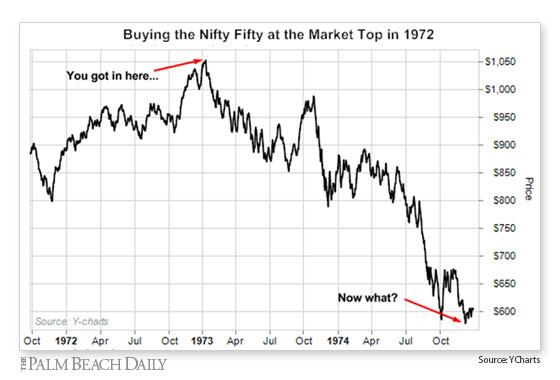
 Are FAANG stocks the new Nifty Fifty? If the moral of one of the biggest investment flops of the 1970s is to be believed, they are.
Are FAANG stocks the new Nifty Fifty? If the moral of one of the biggest investment flops of the 1970s is to be believed, they are.
As we near the end of 2017, one of the big stories of the year is surely the dominant role played by the FAANG quintet of companies on this year’s market gains. Together, Facebook, Amazon, Apple, Netflix and Google represent 20 per cent of the year’s total return for the S&P 500 index. Add in the three comparable tech giants in China, the so-called BAT companies of Baidu, Alibaba and Tencent, and you’ve got about $1.7 trillion in market value, which is more than Canada’s economy as a whole.
Aside from a recent sell-off, there seems to be no stopping the gains, despite concerns that FAANG stocks are way overvalued. Witness the emergence of a FANG+ futures contract by the Intercontinental Exchange group, aimed at giving the enamoured investor even more opportunity to bet on today’s tech giants.
As a result, many are drawing the comparison between FAANG’s rise and the popularity in the late 1960s and early 1970s of what were then known as the Nifty Fifty, a group of growth stocks felt to be sure shots for investors looking for that “one decision” approach. And for a while, they were right.
Featuring industry leaders like Avon, Disney, McDonald’s, IBM and Xerox, the Nifty Fifty kept growing in the early 70s, at first defying bear markets before taking a spectacular tumble in 1974. By 1975, those who jumped in with the Nifty Fifty in 1972, for example, saw over two-thirds of their wealth disappear.
But how close is the match-up between the Nifty Fifty and FAANG? For one, both groups were central to the gains of the S&P 500 in their time and both groups were and are trading at multiples much higher than their earnings, with that fact now causing many to scoff at FAANG, even as its successes keep piling up.
Speaking to BNN about the Nifty Fifty, Norman Levine of Portfolio Management Corp in Toronto said the parallels are clear.
“People paid anything for them, which is reminiscent of what’s happening now,” said Levine. “Except when the bubble in the market ended, these stocks underperformed everything else.”
Levine contends that the issue isn’t about whether or not Google, Amazon et al are good companies with still-rosy futures, it’s about the basics of profitability and valuation.
“I’m not denigrating the companies themselves, I’m denigrating the valuations assigned to them by buyers,” says Levine.
Others have pointed out that whereas the Nifty Fifty were at least diversified across a number of sectors, FAANG is decidedly in the one tech camp, thereby adding a further level of risk.
And yet, even within the Nifty Fifty cluster of also-rans, there were a few shining stars like Walmart and Philip Morris which bucked the trend in the 70s and on their own would have served investors well. Whether any of the FAANG group prove to be those exceptions is still anybody’s guess.
Leave a Reply
You must be logged in to post a comment.



 Share
Share Tweet
Tweet Share
Share




Comment